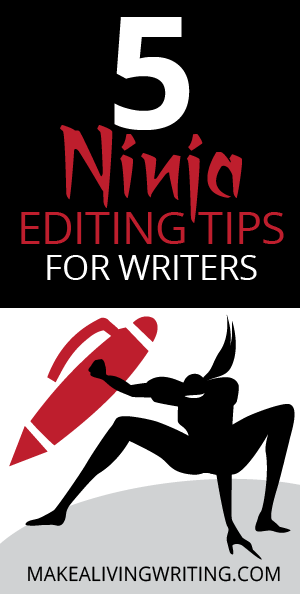
Sorry, but this doesn’t meet a current need.
Not a great fit for us, but we wish you luck elsewhere.
Put your big kid pants on, because you need to face a hard fact: Editors aren’t paid to tell you the truth, tell you what’s wrong with your writing, or help you improve. Their job is to buy and publish good stuff.
Believe me, I know. I’ve edited four national magazines, run a major book publishing company, and written nearly 190 books that have sold over 70 million copies.
I say that not to brag, but to assure you I know what I’m talking about. And I’m telling you that your writing is not coming back because it “just missed” meeting some “current need” or was “almost a great fit.”
You have to submit better work, and that means becoming a ferocious self-editor.
Here are five powerful revision tips to apply to your manuscript before you submit your next piece. Imagine attacking your work like a self-editing ninja.
1. Give the reader credit.
A bloated fail: “The executive assistant told me the CEO could see me now and ushered me through the open door to his office.”
That sentence insults your reader’s intelligence.
It should be rendered, “The CEO’s executive assistant ushered me in to see him.”
Naturally the assistant would’ve said he was available. And is there a reader alive who needs to be told that you entered the office through a door, let alone that it was open?
Give your reader credit for being an adult with a functioning brain.
2. Don’t show off your vocabulary.
That may have impressed your (unpublished) creative writing teacher, but it won’t earn you points with editors.
3.Don’t be an adjective maniac.
Legendary novelist and editor Sol Stein says, “One plus one equals one-half.” He means that if you use two adjectives at a time rather than choosing the stronger of the two, you cut your impact in half.
4. Avoid on-the-nose writing.
This phrase was coined by Hollywood scriptwriters for prose that mirrors real life without advancing the story.
Examples include greetings, introductions, small talk – anything we’ve all heard before. Summarize these and get on with the story.
An example of what not to include:
- “Hi, Jim, how’ve you been?”
- “Good, Fred, and you?”
- “The same. What’s new?”
- “Not much. Oh, did you hear about Pete?”
- “No, what happened?
Avoid all that on-the-nose writing this way:
- After trading pleasantries, Jim asked Fred if he’d heard about Pete.
- “No, what happened?”
- “He was beaten and robbed last night…”
5. Avoid creativity in dialogue attribution.
I’ve had critique groups regale me with all the alternatives they’ve come up with for “he said” and “she said.” I hope they had fun, because they should trash that list.
Break repetition by inserting action (Madison sprawled on the couch. “I’m beat.”). But when you do attribute, “he said” or “she said” is almost always the right choice.
Strap on your ninja sword
Apply these five powerful self-editing strategies to your next freelance effort, and you’ll be amazed at the response you get from the marketplace.
What self-editing tips have helped you get more assignments? Share in the comments.
Jerry Jenkins has written 188 books, including the mega-bestselling Left Behind series. Twenty-one of his books have reached the New York Times bestseller list. He freely shares his proven writing techniques at his website.









